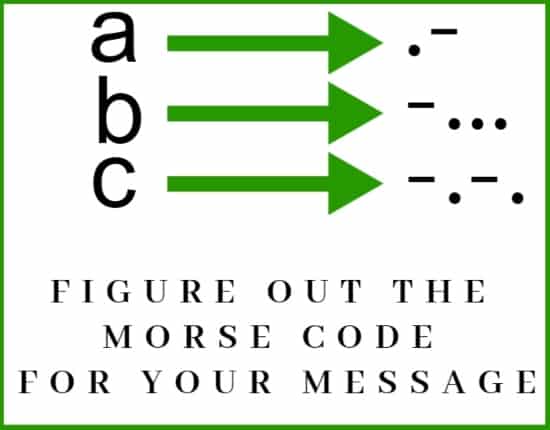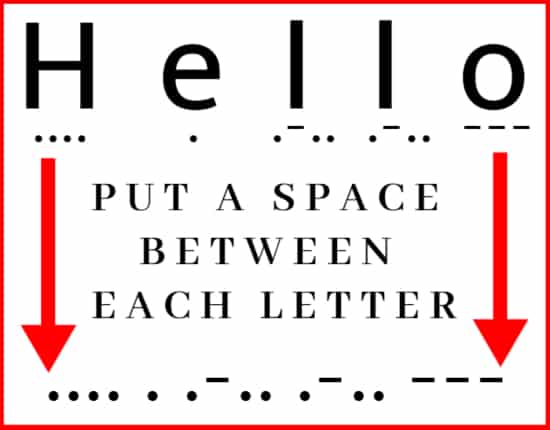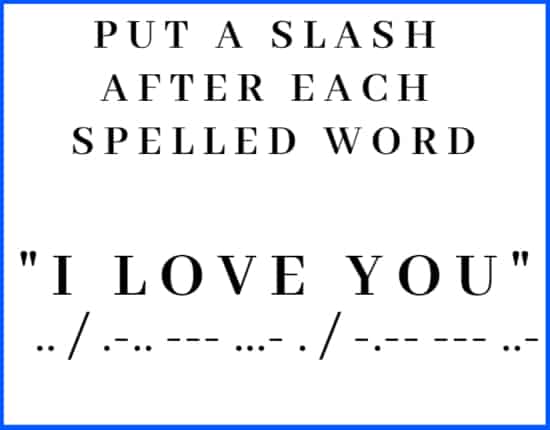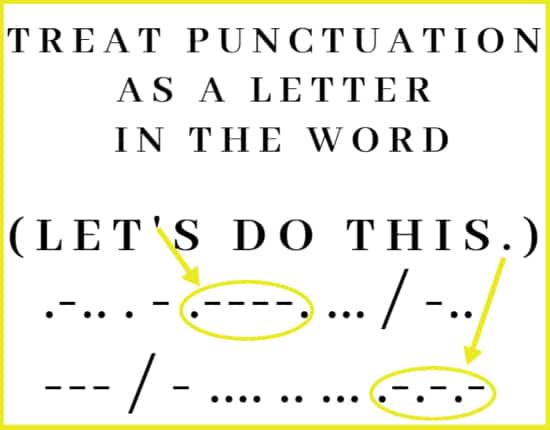It is pretty easy to start writing in Morse code; you just have to know the basic steps to help you get on your way.
Morse code is universal and unique because the alphabet for pretty much any language can be mapped to its signals and can be communicated with it.
This provides encoding for that language as well as enhances the ways it can be used.
Here are the five basic rules to follow when writing (or typing) in Morse code!
1. Find the Morse code Translation for Your Message
You first need to know what signal combinations represent the characters in your message.
If you do not have the Morse code alphabet memorized, you will need a chart or Morse decoder handy to help you get started.
The letters in the alphabet are represented by at least one but up to five signal characters, so these rules are critical for reducing confusion.
There are two basic ways you can write Morse code:
- You can write the actual dot and dash signals themselves; for example, the word “hello” in Morse code would be “.… . .─.. .─.. ─ ─ ─ “. I would recommend doing it this way because it is faster and much simpler. It doesn’t really matter if you choose to write a dash(-) or an underscore(_), but we will use the dash in our examples.
- Another option is to actually spell the dot and dash signals how they sound using “dit” and “dahs,” for example, the word “hello” would be “di-di-di-dit dit di-dah-di-dit di-dah-di-dit dah-dah-dah.”
Once you have figured out what you are writing, you will just use the rest of the rules to make it easy to read and follow.
2. Put a Space After Each Letter
The second basic rule is to leave a space after each letter in a word; otherwise, you will mix your signals and make it near impossible to read.
As you can see, the spaces clearly show where each letter starts and ends.
3. Write a Slash After Each Word
To make it easier to read and understand, put a slash after completing the spelling of a word.
For example, for the phrase “I Love You” in Morse code, you would write, “.. / .─.. ─ ─ ─ …─ . / ─.─ ─ ─ ─ ─ ..─“
There should be a space before the slash already because of the space after each word, but you should also put one after.
Once again, this spacing cleans up and organizes the writing for easy readability.
4. Treat Punctuation as a Letter in the Word
When you use punctuation in Morse code, you just treat it as a letter in the word. That means a period at the end of a sentence is just added like another letter at the end with just the regular space between letters.
For example, the phrase, “Let’s do this.” would be “.─.. . ─ .─ ─ ─ ─. … / ─.. ─ ─ ─ / ─ …. .. … .─.─.─” Notice the apostrophe is represented by “.─ ─ ─ ─.” and in “Let’s,” it is just spelled out within the word. The same rule applies to the period at the end of this small sentence.
If you were writing another sentence after this one, you would just put a slash after the period’s dot and dash combo and start writing again.
5. Don’t use Capitalization in Morse Code
Last but not least, remember there is no way or real way or need to capitalize in Morse code.
It wasn’t deemed necessary with the creation of the code and would add unwanted complexity to the code.
The spacing is key to understanding Morse code messages no matter if it is tapped, written, or even spoken.
How to Write Morse Code Sentences
Here are five examples of how to write or type sentences in Morse code:
| English Sentence | Written Morse Code Translation |
| 1. This is how you write in Morse code. | ─ …. .. … / .. … / …. ─ ─ ─ .─ ─ / ─.─ ─ ─ ─ ─ ..─ / .─ ─ .─. .. ─ . / .. ─. / ─ ─ ─ ─ ─ .─. … . / ─.─. ─ ─ ─ ─.. . .─.─.─ |
| 2. I am from the United States of America. | .. / .─ ─ ─ / ..─. .─. ─ ─ ─ — / ─ …. . / ..─ ─. .. ─ . ─.. / … ─ .─ ─ . … / ─ ─ ─ ..─. / .─ — . .─. .. ─.─. .─ .─.─.─ |
| 3. What is your destination? | .─ ─ …. .─ ─ / .. … / ─.─ ─ ─ ─ ─ ..─ .─. / ─.. . … ─ .. ─. .─ ─ .. ─ ─ ─ ─. ..─ ─.. |
| 4. What is your name? |
.─ ─ …. .─ ─ / .. … / ─.─ ─ ─ ─ ─ ..─ .─. / ─. .─ ─ ─ . ..─ ─..
|
| 5. Learning Morse code is not as hard as it may seem. | .─.. . .─ .─. ─. .. ─. ─ ─. / ─ ─ ─ ─ ─ .─. … . / ─.─. ─ ─ ─ ─.. . / .. … / ─. ─ ─ ─ ─ / .─ … / …. .─ .─. ─.. / .─ … / .. ─ / ─ ─ .─ ─.─ ─ / … . . ─ ─ .─.─.─ |
Final Thoughts
I hope this explained how you can more clearly write in Morse code when you get the urge. Keep in mind that if you are using it to hide a message, while this can protect it at first glance, people will probably recognize it and can look up the translation.
If you are trying to write in code that no one can read or translate easily, consider making your own Morse code key by matching different combinations of dots and dashes to letters to make your own adaptation of the code.






